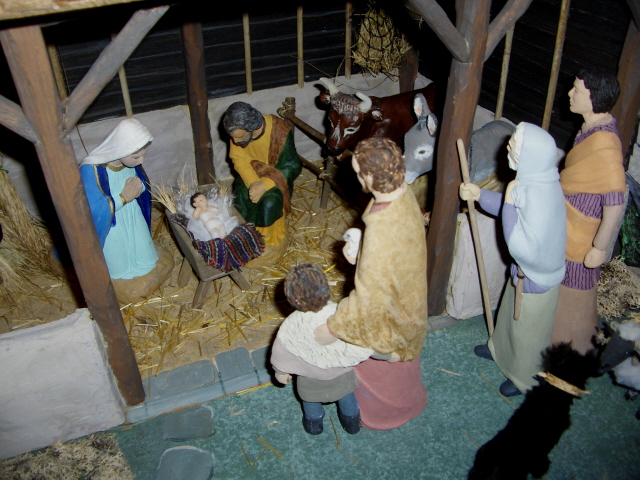Christmas (Christ’s Mass) is the Feast of Our Lord’s Birth. The liturgical colour is white, symbolising joy. It was being celebrated at Rome in 354 AD but had already been observed fairly widely in the West before this date, perhaps before the end of the third century in some places. (1) The Gospels provide no evidence as to the exact date of Christ’s Birth. However, St Chrysostom preached a sermon in Antioch in around 386 AD in which he encouraged all the people to celebrate Christ’s Birth on December 25th, in line with the practice of the Western Church. (2)
It is possible that December 25th was chosen because in the Roman Empire it was the date of the well-known pagan solar feast of Natalis Invicti (Birthday of the Unconquered). As early as the third century AD, St Cyprian was making a connection between the births of Christ and the sun. And still today solar symbolism and language is evident in our hymns (3); for example:
“Wakened by the solemn warning
let the earthbound soul arise;
Christ, her Sun, all ill dispelling,
shines upon the morning skies” (4)
“Hail, the heaven-born Prince of Peace:
hail, the Sun of Righteousness.
Light and life to all he brings,
risen with healing in his wings”. (5)
See Malachi 4:2 – ‘wings’ means ‘rays’ (6)
“In the heavenly country bright,
need they no created light;
thou its light, its joy, its crown,
thou its sun which goes not down…” (7)
At Christmas we read a wonderful broad sweep of Scriptural passages that tell of the “loving purposes of God from the first days of our disobedience unto the glorious Redemption brought us by this Holy Child…” (8). And of all these readings, none captures the true meaning of Christmas more than the first verses of St John’s Gospel, culminating in the words, “And the Word became flesh and lived among us…” (John 1:14).
He took flesh as a baby. “…Christmas does not allow us forget that; if you had met Him then, you would not have been able to do towards Him more than you can towards any lovable little baby that looks at you with its blue whites to its eyes and catches hold of your thumb with its incredibly strong miniscule fingers ending in pink nails so tiny as to be almost laughable. You cannot say anything to such a baby; you can do nothing but love it…” (9)
But of course there is far more to it than that. “We love because he first loved us” and gave his life, “a ransom for many” (NRSV, 1 John 4:19; Matthew 20:28). So we sing with joyful, thankful and loving adoration:
“Child, for us sinners poor and in the manger,
we would embrace thee, with love and awe;
who would not love thee, loving us so dearly?...
O come, let us adore him,
Christ the Lord”. (10)
A very happy and blessed Christmas to all visitors to the Holy Faith website
References
1. Dix, G. (1945) The shape of the liturgy, Westminster: Dacre Press.
2. Knight, K (2009) New Advent Catholic Encyclopedia: Christmas. Available from:
http://www.newadvent.org/cathen/03724b.htm (Accessed 29 November 2016) (Internet).
3. Knight, K (2009) New Advent Catholic Encyclopedia: Christmas. Available from:
http://www.newadvent.org/cathen/03724b.htm (Accessed 29 November 2016) (Internet).
4. Latin, fifth century, translated by Caswall, E. (1849) Hark! a thrilling voice is sounding. Available from:
http://www.cyberhymnal.org/htm/h/t/hthrillv.htm (Accessed 29 November 2016) (Internet).
5. Wesley, C. (1739) and others Hark, the herald angels sing. Available from:
http://www.oremus.org/hymnal/h/h078.html (Accessed 29 November 2016) (Internet).
6. Jerusalem Bible (1966) Note k on p.1547.
7. Dix, W.C. (1860) As with gladness men of old. Available from:
http://www.oremus.org/hymnal/a/a371.html (Accessed 29 November 2016) (Internet).
8. Milner-White, E. ‘Bidding prayer before a Christmas Carol Service’, In Milner-White, E. and Briggs, G.W. (editors) (1959) Daily prayer, Harmondsworth: Penguin Books. (This bidding prayer is also available in Common Worship Times and Seasons: Christmas on page 88).
9. Martindale, C.C. (1931) What think ye of Christ? London: Sheed & Ward.
10. Wade, J.F. (Latin c 1743), stanzas 1-3 and 6 trans. Oakeley, F. (1841); stanzas 4 and 6 trans. Brooke, W.T. (1848-1917). O come, all ye faithful. Available from:
http://www.oremus.org/hymnal/o/o070.html (Accessed 29 November 2016) (Internet).
Short talks
Short talks entitled The soul’s own Christmas, Faith and joy, The Babe of Bethlehem, The stable, Christmas Eve and The relevance of Bethlehem are available in this section of the Holy Faith website. The following are suitable for children: The Roman Empire, The Birth of Christ and Jesus Christ, his only Son Our Lord.
Christmas crib at the Parish Church of St Peter and St Paul, West Wittering, England. Note the spiky anti-wolf-attack collar on the sheepdog!
